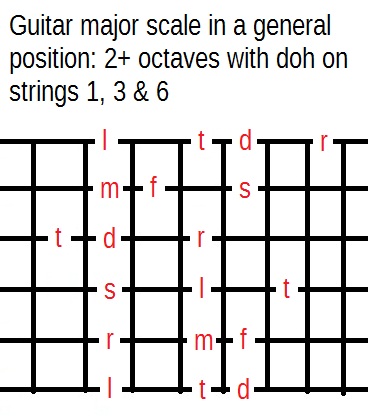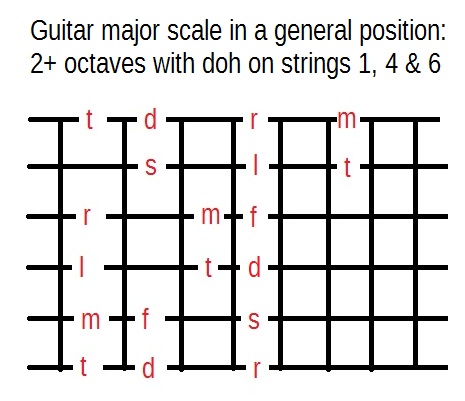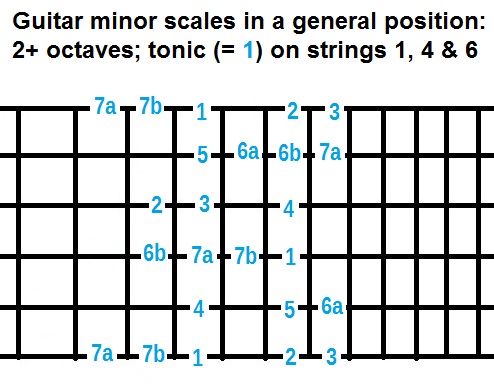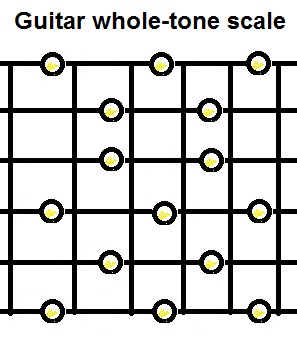
Last amended: 9 January 2014
The diagrams on this page may be of help to guitarists learning to play melodies and wishing to develop the skill of playing the tunes in any key. Of course a knowledge of scales is helpful in other ways, including for improvisation, reading music and composing. Apologies to left-handed players - it's all set out for right-handed players, standard tuning.
Each major-scale diagram shows a section of guitar fingerboard, the strings and frets, with the positions of the notes doh, re, me, fa, so, la, ti, giving over two octaves of scale. Most of the notes shown in each diagram can be played without moving the left hand up or down the fingerboard, which is helpful (mentally and physically), and then the best fingering for the left hand may be one finger for each fret.
Beginners may wonder why notes of the scale on the same string are one fret (one semitone) apart in some cases but two frets (two semitones) apart in other cases. The structure of the major scale is discussed in the Some basics section of the Guide to chord symbols on this website.
Once a melody has been learnt in doh-re-me terms, the information in the diagrams will usually enable the melody to be played in any key. Or maybe in the same key in a different octave. This will involve choosing which of the three diagrams suits best (not always easy to get right first time) and figuring out the required fingerboard position (which is often done using a knowledge of the notes on the first string).
The diagrams may also be of some help when reading music. Suppose, for example, that the music is in Eb major. A guitarist who knows that, in this key, Eb = doh, F = re, G = me, Ab = fa, Bb = so, C = la and D = ti may be able to interpret the written music in doh-re-me terms (which is what some singers sometimes do when reading music), and then translate that into guitar fingerboard terms (strings and frets).
The standard way of dealing with a minor scale in doh-re-me terms is still to use doh, re, me etc but with la as the tonic (the home note) instead of doh. So each of the major-scale diagrams below can be re-interpreted as a minor-key diagram by taking the tonic as la instead of doh. Key signatures for written music generally work that way too. For instance, if the key is C minor, since the note C is la for the Eb-major scale, the standard key signature for C minor is the same as for Eb major (three flats).
(1)
(2)
(3)
If diagram (1) is being used, and there is a need to go a little higher up the neck, then the guitarist can switch to diagram (2). There are various ways of thinking about the connection between diagrams (1) and (2) - for instance the la on the first string is the same note in both diagrams.
If diagram (2) is being used, and there is a need to go a little higher up the neck, then the guitarist can switch to diagram (3). There are various ways of thinking about the connection between diagrams (2) and (3) - for instance the ti, doh and re on the first string are the same notes in both diagrams.
If diagram (3) is being used, and there is a need to go a little higher up the neck, then the guitarist can switch to diagram (1). There are various ways of thinking about the connection between diagrams (3) and (1) - for instance the me on the first string is the same note in both diagrams.
Specifically for minor scales, we give just one example. It has the tonic on strings 1, 4 & 6, and so has some similarities to the major-scale diagram with doh on strings 1, 4 & 6. We are using 1, 2, 3, 4, 5, 6, 7 to represent the notes of the minor scale. 6a and 6b are alternatives for note 6. 7a and 7b are alternatives for note 7. These alternatives allow for all the different common types of minor scale in western music. For instance, for the dorian mode the notes are 1, 2, 3, 4, 5, 6b, 7a. For the la-ti-doh-re-me-fa-so-la minor scale mentioned above the notes are 1, 2, 3, 4, 5, 6a, 7a, and since 3 = doh in that way of thinking, this minor-scale diagram also has similarities with the major-scale diagram with doh on strings 1, 3 & 6.
(4)
Afterthoughts
It may be helpful to relate each of the diagrams to the chord shape suggested by the positions of d, m & s, or, for the minor scales, by the positions of l, d & m or of 1, 3 & 5.
Standard guitar tuning is a good compromise between what suits playing chords and what suits playing melodies. For the sake of that compromise - for ease of chord playing - there is only a major third between the G and B strings, whereas in every other case there is a perfect fourth between neighbouring strings. This irregularity in the pattern of standard tuning causes irregularity in the pattern of guitar scales. It is not a problem met by violinists, say, since a violin has the same interval (a fifth) between each string and the next. For a violin, the diagram for a one-octave major scale on strings 4, 3 & 2 would be the same as for a one-octave major scale on strings 3, 2 & 1, but one string up, of course.
The following diagram for a whole-tone scale shows a pattern that is just like a checkerboard except for a one-fret "slip" between the G and B strings due to that major third between those strings.
(5)